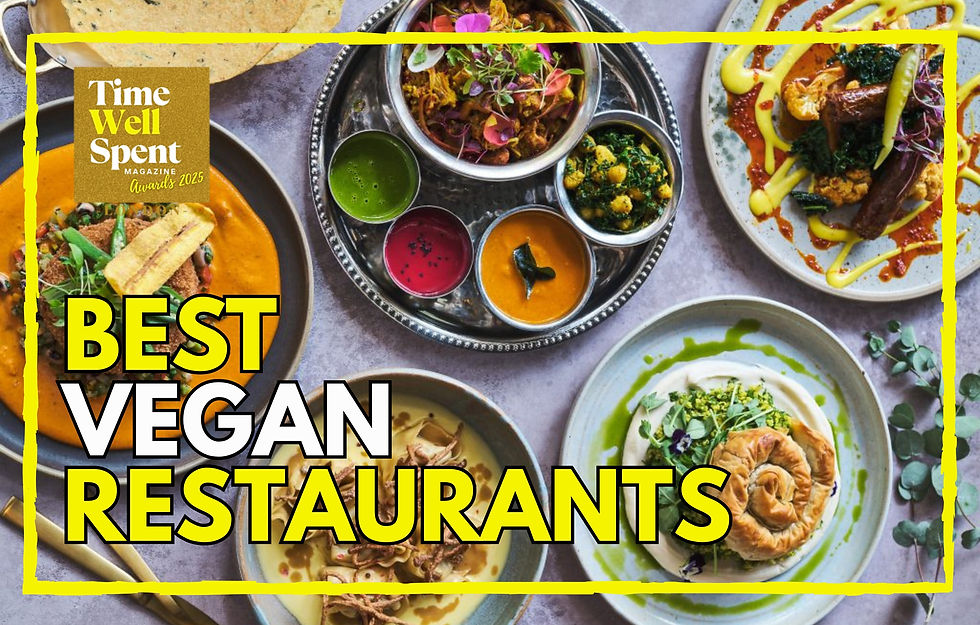REVIEW: THE WRIGHT BROTHERS OYSTER MASTERCLASS
- FK
- Oct 26, 2023
- 5 min read
Updated: Oct 30, 2023
Give a Shuck About the World’s Most Sustainable, “Vegan” Superfood

A delicious superfood older than dinosaurs and grass, packed with minerals and vitamins, popular with vegans and the world’s most sustainable protein source. It even fights against climate change.
Where do I sign up?
_____________________
Well, the Wright Brothers’ Oyster Masterclass is an excellent way to start.
We head to their cosy, riverside restaurant in Battersea for one of their legendary, two-hour masterclasses, eating natural, dressed and cooked oysters, washed down with Champagne and martinis and learning how and why to eat these extraordinary shellfish, concluding with a good shuck.

Our charming Oyster Master - sadly, not crowned in shells or emerging with billowing hair from a scallop - begins by asking us about our first oyster experiences. Mine was of my throat rejecting the snotty ball my dad had encouraged me to swallow in France as a teenager.
This might have led to an oysterless life, had it not been for a trip to an extraordinary seafood event in Maine, where I attempted it again, first dressed and then natural - tasting the ocean’s kiss - which is where my love for these fascinating molluscs began.
But I had no idea how little I knew about them, or how badly I was eating them, until this class.

He gives some history to Wright Brothers - not actual brothers, but brothers-in-law. One was a lawyer and one a music producer, who made Madonna’s Erotica. But they kicked all of that to the curb in 2002, opened London’s first oyster and porterhouse in Borough Market in 2005 and now own three restaurants and have supplied the capital’s top dining destinations with fresh fish and shellfish for more than 20 years.
Their passion is to make oysters accessible again - as they were in the beginning - and no longer the stuffy, elite food they have become.
Then we deep dive into the shiny, pearls of wisdom. And they’re good - it’s a masterclass in oyster indoctrination and I am merrily gulping the Kool Aid and brine.

Oysters are crazy little hermaphrodites which grow one leg and are popular with vegans, because they're cruelty-free - although eaten live, they have no brain or central nervous system, so aren’t sentient and don’t feel pain.
They are also one of the world’s most sustainable protein sources, since they don’t eat other creatures and impact wild stock populations.
And uniquely, oyster farming actually has a positive impact on the environment - they are climate change heroes because each oyster filters 100-200 litres of water a day, protects coastlines, creates thriving ecosystems, captures carbon dioxide, and provides plentiful protein.

Now, onto the tasting. My Champagne glass is topped up for the third time with Wright Bros own Piper-Heidsiek Champagne - pleasingly, it’s important to take a glug between each oyster, to reset the palate and remove the metallic aftertaste.
A silver dish arrives with five natural oysters on ice in different sizes, shapes and colours. The class is similar to a wine tasting. In wine, you taste a region’s “terroir" - the factors in the grape’s production that create its unique flavours. In oysters, it’s “merroir" - the unique flavours and textures of each oyster, caused by factors like the water, tides, soil and what algae it’s eating. There are three flavour profiles, oceanic, earthy and creamy and this class promises to help us identify our own profile flavour palate.
The first is a Celine oyster from Brittany. And we discover the six steps to oyster eating while we taste it.
The first is “nose” - we make sure it smells like a light sea breeze and not fishy. Then we sip the salty liquor around the meat, to prepare the palate for what’s to come. Next, we release the meat - the Oyster Master shows us how to properly remove it from the shell, which is when I learn that the muscle (the part I never successfully remove) is the sweet part, which totally alters the flavour. And then we pour it into our chops.

I’ve always been an oyster chewer - swallowing is a salty and pointless waste of money. They encourage us to chew three to four times to release the three separate characteristics - the liquor’s brininess, meaty umami (caused by the algae it feeds on) and the minerality, that lingers on the tongue.
Next, we study the aftertaste - fast-growing oysters (warm water) are meaty and plump with a short aftertaste and slow-growing are the opposite.
Finally, we turn the empty shell over to show that we weren’t dragged up and to admire its layers of growth over the years.
The next is a Jersey oyster - this is apparently the best introduction to oysters, as it’s lean and not too metallic, with sweet, grassy, melon flavours.

This is followed by my personal favourite - the Kelly Native from Galway; a giant beast, which fills the shell and is swimming in brine from the Atlantic, which apparently has the best water. It’s buttery, meaty and salty.
Then my least favourite - and the oldest, at four years - the Ostra Regal from Ireland: earthy and nutty.
New, Piper-Heidsiek Muscadet Champagne is uncorked for the dressed oysters. There’s a Hogwash oyster with shallots and cider vinegar and a Cucumber, Apple and Dill dressed oyster, which one guest correctly notes "tastes just like a Big Mac."

They’re delicious, but you can’t taste the oyster and might as well be eating tofu. It’s like making sangria with good wine.
Finally, the cooked oysters arrive, and the Oyster Master can barely contain his contempt for them. We’re given Martinis to accompany them, made with Wright Bros Half Shell Gin.
The New Orleans is deep fried in its shell with tartare sauce. It’s lovely, but could be scampi or any mystery, fried seafood. The Rockefeller oyster is cooked and topped with spinach and herb butter. Apparently, this dish was invented by the Rockefeller family in 1889 after a snail shortage. And both of these American-style, cooked oysters were essentially created to make rubbish oysters palatable.

Finally, we take turns to learn how to give the oysters a good shuck - putting the shell “to bed” in a napkin and expertly cutting and scooping with the knife, to release the meat and its sweet abductor from the shell.
Before we leave, we are each given a very generous Wright Bros tote, containing our own Oyster Knife and apron to continue shucking at home, a Little Oyster Handbook and a large bottle of the Wright Brothers Half Shell Gin.

I took this class in October, but discovered that oysters and these masterclasses can be enjoyed in months without an R, as well. The R Rule myth is borne from a need to protect native and flat oysters in reproductive months, but they are edible - and creamier - out of season and Pacific oysters can be eaten all year round.
No month will be safe from my shucking and smug pearls of wisdom, from now on.
The Wright Brothers Oyster Masterclass, 26 Circus West Village Battersea Power Station, London SW11 8EZ. Oyster Masterclasses are hosted on the first Saturday of each month. Includes 10 oysters, Champagne, wine, Martini and gift bag. £125 per person.







































































Comments